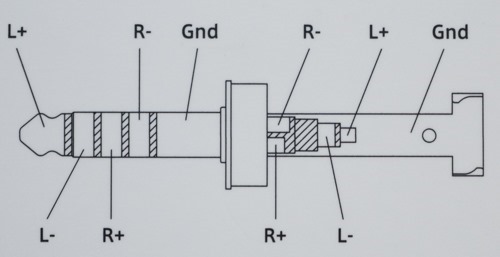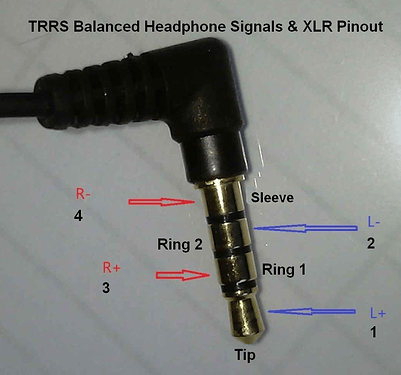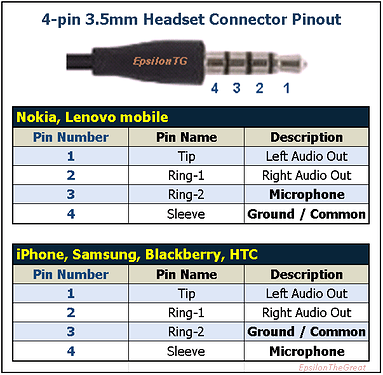Balanced on the amp side and single ended on the headphone side is a no-no, but the other way around is perfectly fine.
I don’t know the circuitry of the Zen Can, but I can suspect it uses the amplifiers out to either.
The difference is in the power. For 6xx, more power from balanced is gonna be better. Underpowering headphones is a thing and can leave them struggling to perform at their standard level. You can buy 4.4 to Senn cables on Aliexpress for like $20-40. Then a cheap 4.4 to 3.5 adapter if you don’t want to swap cables to run single-ended.
So I was googling and reading to understand the actual difference between the connectors and. the balanced / unbalanced signals. However what I still fail to understand is this:
So TRRS can carry a balanced mono signal while TRRRS can carry a balanced stereo signal. So if my headset has a TRRS connector because it has a integrated microphone and I would add the balanced 4,4 adapter on it and plug it in a balanced 4,4 amp out, would that:
- turn the amp out signal into a balanced mono (because the headphone uses the additional channel for the mic) but otherwise would do no harm to the amp or the headset
- be harmful to the amp / headphone because the amp sends a balanced stereo but the headset can not convert it correctly?
In a balanced connection, each channel has a separate ground connection, but in a single ended (non balanced) connection the channels share a ground.
When you connect a unbalanced headphone to a balanced headphoneamp connector you are bridging the ground connections and that can damage your gear.
Whenever the destination device is balanced and the source is single ended, you can just do that.
- You can’t short out a headphone as it is a passive device
- When a balanced device shorts out an unbalanced source, the same is true for a balanced source.
@Freyr thanks for the link. I understand that with XLR connectors as example because its pretty obvious. But with the 4,4 pentaconns and TRRS / TRRRS it’s less obvious to me.
From what I’ve understood how balances works is that instead of determine the relative impedance between the + / - signals to the ground there the signal is split into 2 channels (left and right) and a inverted signal is created for each of those channels.
So according to Balanced vs Unbalanced Audio Connections - Headphonesty a TRRS connector is (can be?) a balanced connector.
And this is where my understanding ends. Having a TRRS connector on a headset that uses the channels as L / R / Ground / Mic on a balanced output amp … does what exactly?
Sorry I’m not Freyr, but I’ll try to help. TRRS can be used as a balanced connection or an unbalanced with mic. If it is a balanced headphone, then the TRRS will be used for the positive and negative paths of the left right channels. If it is an unbalanced headphone with mic, it would do weird things. I personally never done it before, but hey maybe you can do it and report back what happened ![]() .
.
Pentacon works like 2 XLRs (or dual TRS) in one:

Yes. TRRS can be like so:
Or one of these:
Balanced works by having the same signal but 180° apart (= upside down).
In a balanced setup, “Ground” does not carry any signal (“shield” would be the correct name for it).
I just want to add one more. The Pentacon plugs were designed by Sony not only for audiophiles, but also the professionals. IIRC from their release note, the fifth connection was intended for shielding in professional gears. Most of us don’t use shielding on our cable, and I don’t think I’ve ever seen any Pentacon cable that has shielding, but that was the idea. The fifth connection is there if anyone want to use it for shielding.
Any standard microphone cable has two conductors and shield, there are also somewhat common 4 conductor + shield cables.
Yea, but I feel like the Pentacon didn’t take off like what Sony wanted. I’m yet to see a professional gear that fully use the 4.4mm Pentacon as intended.
Getting off-topic here:
Because it is stupid for pro use!
Any studio or rental company has miles upon miles of XLR and accessories of XLR. XLR is robust (because metal outer shell).
TRS is nice when size is limited, but XLR is the robust allrounder.
On mixers, you can’t go more compact as your fingers still need room to work in anyway.
That’s exactly what I (though unconsciously ![]() ) did. Added a balanced 3,5 female to 4,4 male adapter on the TRRS input of my headset with mic and plugged that 4,4 balanced into the balanced output of the Zen Can.
) did. Added a balanced 3,5 female to 4,4 male adapter on the TRRS input of my headset with mic and plugged that 4,4 balanced into the balanced output of the Zen Can.
And it seems to work without issues. But I’m worried that even it appears to work, it might short my amp in the long run. Therefore I’m trying to figure out if that could be the case. ![]()
Ah I see. I can’t really comment for your specific case. I’ve only seen what could happen if a TRS headphone connected to a balanced source.
No worries …I tried to dig in the technical details but couldn’t find any clues if that is supposed to work or not.
So for now I’ll simply won’t do it because nobody seems to know if that could be an issue or not. 
So one more thing here …
I pulled out my 90s equipment … a creative FPS 2000 surround sound thing. Which is a subwoofer and 4 satellite speakers connected to the subwoofer.
The subwoofer has 2 inputs:
- 2 x 3,5mm jacks (1 for each pair of speakers)
- 1 Digital DIN (looks like an XLR with 9 PINs)
My Zen Can has a balanced 4,4 pentaconn output. (I’m keeping the unbalanced 6,3 for the headphones).
How the hell do I connect that? 
Since the zen can has only a balanced output and the sub has 2 mono 3.5 jack input you should connect directly your DAC to the sub with an RCA to jack 3.5 mono and eventually buy an RCA splitter. So you connect the DAC to the input of the spitter/selector an output of the spitter to the zen DAC and an other to the sub and select what you are using each time
Thanks @lafonte!
the sub has 2 mono 3.5 jack input
Actually I think these are 2 stereo inputs since each drives 2 speakers. So one jack is front left / right, one jack is rear left / right.
Does that make any difference to what you proposed?
In that case you need a 4 channels dac, or connect the sub to the dac with an rca to stereo 3.5 jack but you will get a stereo system with 2 speakers for channel and a sub. The spitter will work but just using the system in stereo
edit: drive 2 amplifiers with a single signal can cause problems, so probably connect the mono signal to the stereo input of the sub can be a solution that is less than optimal. better check the manual of the system first.

